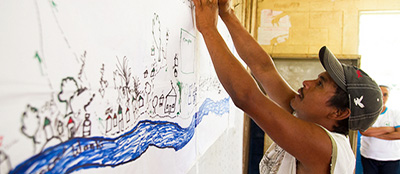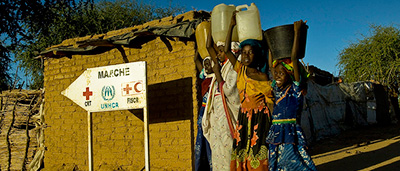This report focuses on humanitarian and disaster risk reduction interventions that aim to reinforce economic resilience to anticipated shocks and support economic recovery after a shock, both in situations of natural disasters and conflict. There is limited evidence on the economic impacts of indirect market support interventions because: Providing indirect support to ...» more
Humanitarian Issues
Mobile phone and social media interventions for youth development outcomes
Young people are often ‘first adopters’ of new technologies, particularly broadcast technologies such as mobile phones. The upsurge in ICT usage has had a direct impact on increasing civic engagement among youth, providing new avenues through which they are informed, shape opinions, organise, collaborate and take action. A number of barriers and challenges remain that must ...» more
Disaster risk financing and insurance in the Pacific
The Pacific region has low insurance penetration compared with other parts of the world. General (non-life) insurance penetration for Pacific countries ranged between 0.5% (Indonesia) and 2.5% (Samoa) in 2012. The mean penetration rate for Pacific countries for which data could be obtained was 1.6%, which is considerably less than the rate in Australia (2.2%), half the rate of ...» more
National humanitarian response
National governments have the primary responsibility for leading and coordinating humanitarian response in their countries. Where they have the capacity, state-led responses have been evaluated to be more effective than responses led by others. However, international actors often fail to work effectively with national authorities. The cases studies analysed in this review ...» more
Restrictions on humanitarian access
Humanitarian access is a challenge in many armed conflicts, both in areas controlled by state and non-state actors. While there is some general guidance on strategies to address such access constraints, there is very little publicly documented evidence on how humanitarian organisations have overcome specific instances of governments and de facto authorities’ attempts to ...» more
Mainstreaming disaster risk management
Positive developments in the process of DRM mainstreaming have involved: The designation or creation of a high-level agency/department/ministry to lead DRM mainstreaming Working groups or committees to coordinate all the stakeholders Cross-sectoral DRM strategies The incorporation of core DRM concerns in development and/or infrastructure projects The ...» more
Video of seminar on Mass atrocities
A video of Chandra Sriram‘s GSDRC seminar is now available below. Professor Sriram explored three critical issues in developing responses to mass atrocities introduced in her Professional Development Reading Pack on the same subject. Chandra Sriram is Professor of International Law and International Relations at the University of East London. This seminar was held on 8…» more
Subnational disaster risk management involving communities in Nepal
In a bid to better tackle risk (exposure and vulnerabilities) and its management (capacities and resilience), domestic and foreign actors have promoted disaster risk management (DRM) that involve communities at the levels of regions, districts, municipalities, wards, or smaller-scale units such as schools. Key findings of the literature review include: Successful ...» more
Refugee return in protracted refugee situations
Voluntary repatriation/return is seen as one of the durable solutions to protracted refugee situations and is the ‘preferred’ solution of the international community. Successful or sustainable return processes require the reintegration of refugees, which can be complicated by their protracted refugee experience and conditions in the country of origin. Evidence from case ...» more
Economic development in fragile and conflict-affected states
This Topic Guide draws on lessons from programmes and case studies to explore which types of economic development interventions can be effective in FCAS and which factors have contributed to successes and failures. ...» more
Lessons learned for national state entities for recovery and reconstruction
Key indicative lessons learned for national state entities from the literature reviewed include: Structure Develop national recovery frameworks in advance of disasters. Appoint a lead agency with a built-in end date, a clear legal mandate and an experienced politically aware leader. Integrate the immediate humanitarian action into the government-coordinated recovery ...» more
Impact of multilateral organisations on humanitarian outcomes
Even with strong evidence on programme impact, it is hard to attribute humanitarian results directly to multilateral organisations’ (MLOs) or specific forms of aid architecture. In an emergency context, there tend to be many actors and interventions and it is difficult to show a direct chain of causality between specific funding streams or organisations and results. The key ...» more
Influencing laws and guidelines on humanitarian assistance
International humanitarian law (IHL) and international disaster response laws, rules and principles (IDRL) set out rules and guidance on how to access affected populations, and how to deliver humanitarian assistance, during armed conflicts and disasters. This includes guidance on customs clearance and the taxation of relief, among other areas. IDRL is a fragmented collection of ...» more
Acceptance strategies in conflict
Acceptance is a risk management strategy based on reducing threats to aid workers by reducing the motivation of others to harm them. The thinking is that if aid work is viewed positively, it will generate goodwill towards aid workers and allow them to work safely. Degrees of acceptance can vary, ranging from a high level…» more
Crisis management models in Africa
The rapid review uncovered very little literature detailing general crisis management models in Africa. It found almost no literature on the experience of using such crisis management models in relation to crises such as public disorder, political unrest, and epidemics. However, some independent evaluations of crisis management models used to respond to food security crises ...» more
Multi-agency stabilisation operations
While there is as yet limited empirical evidence of what works best in multi-agency – or ‘whole-of-government’ – approaches to stabilisation, the literature does identify some lessons learned and principles of good practice. These include: Overcoming common challenges: establishing transparent processes to identify and manage tensions and trade-offs between neutral humanitarian ...» more
Relationship between humanitarian and development aid
There are various approaches to understanding the relationship between humanitarian and development aid. Some literature points to a specific time period; envisaging the humanitarian-development gap as a temporal period when a humanitarian operation is about to be completed, and development and reconstruction projects are about to begin. Others refer to an institutional gap ...» more
Lessons from Female Engagement Teams
Evaluations of Female Engagement Teams (FETs) used by the military to engage with women in Afghanistan that are available indicate that: Female soldiers have had a deescalating effect as Afghan males generally accepted females being searched as long as it was done by other females. FETs have had positive engagement with both women and men and were viewed as a kind of ‘third ...» more
Global issues and debates
Page contents Coverage, scale and systems Financing and affordability Political economy Targeting Conditionalities Shocks and risks Fragile and conflict-affected states State-building Coverage, scale and systems The last 15 years have seen a huge increase in social protection programmes, both the number of programmes and number of countries which have ...» more
Gender and humanitarian issues
A wealth of academic research and UN, INGO, NGO and CSO publications document the differences between the needs, capacities and perceptions of women and men and boys and girls on the types of humanitarian assistance needed in a natural or man-made disaster. When these different perspectives are not taken into account interventions are not effective…» more


